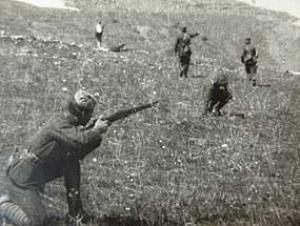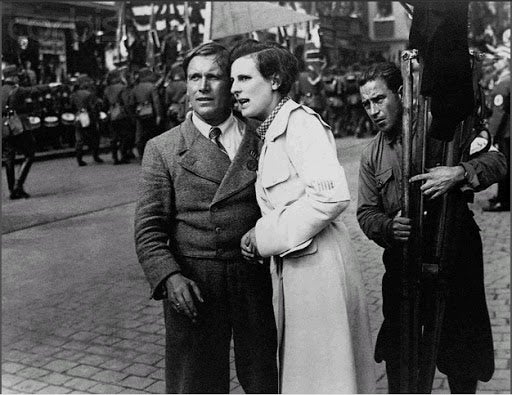The Second Balkan War in 1913 was not only a prelude to World War I, a year later, but also to the ethnic cleansing that would plague the Balkan Peninsula until the end of the 20th century and is in fact still not resolved. In the Second Balkan War, the Bulgarians attacked both the Greeks in Macedonia, and the Serbs closer to Albania. All three countries had been allies in the First Balkan War against the crumbling Ottoman Empire, but the Bulgarians wanted more of Macedonia. As the feature length war documentary, Mit der Kamera in der Schlachtfront, released in the United States as With the Greeks in the Firing Line demonstrates, the Bulgarian Army was quickly defeated, losing even more territory.
With the Camera at the Front, a more direct translation of the German title, was released in German and French cinemas in October 1913, a scant three months after the beginning and end of the war. King Constantine I of Greece had given a German team permission to shoot at the front, having himself received the rank of a German Field Marshall by the Prussian Kaiser. Surprisingly, it catalyzed a debate in the German press about the complicated subject of war films: are they inherently anti-war, because of the visualization of death and destruction? Or propagandistic, due to the visual fascination exerted by images of war? Robert Schwobthaler, the film’s director, intended his documentary to be anti-war, as he noted in an article in a leading German trade periodical in October 1913:
“The world’s newspapers have reported on the devastation and destruction of the cities of Demir-Hissar, Serres, Kavalla, etc. at the hands of the Bulgarians. We have captured those reports as far as possible in living pictures which historically document the unbelievable destruction in Macedonia, and the atrocity of war; it is the naked truth of an eyewitness.”
The film was shown to Kaiser Wilhelm in Berlin in December 1913, who supposedly reacted extremely positively to the images on the screen, another indication of the ambiguous nature of war images, no matter what the maker’s intention. In 1914, the film opened successfully in the United States, Hungary, and Greece. By 1916, authorities banned the film in Germany “for the duration of the war.”

Viewing the film recently after it was premiered at the UCLA Festival of Preservation by our preservationists Blaine Bartell and Jeff Bickel, I was struck by how the film was both boring and fascinating. There are endless shots of marching soldiers, of Macedonians cheering on the Greek “liberators,” but also scenes of destruction and gruesome images observing field hospital doctors and nurses patching up the wounded. After a while one gets sucked into the film’s details, the infinite variety of physiognomies, the particulars of dress, the subjects’ confrontations with the camera. There is only one scene of actual combat footage, and that is probably staged. A long shot of soldiers advancing up a hillside shows infantrymen falling and then not moving at all. No one comes to their aid. Are they really dead from enemy bullets or just waiting directions from the director? Schwobthaler and others complained repeatedly that it was far too dangerous to get actual combat footage, because one could never know where a shell might land, placing the film crew in mortal danger. Armies later solved that problem by drafting cameramen and ordering them to the front.
"After a while one gets sucked into the film’s details, the infinite variety of physiognomies, the particulars of dress, the subjects’ confrontations with the camera."
The UCLA print with english titles was widely distributed in the United States, but also may have been a different version than the one seen by Kaiser Willy. Blaine Bartell tells me the UCLA print is significantly longer than the German censored version and includes two different styles of intertitles, one clearly originating in Germany, the other possibly added in America.
The original three reel feature was produced by Schwobthaler and Express-Film, a German documentary film production company in Freiburg im Breisgau, which had been in business since 1909. Far from the German film industry production centers in Berlin and Munich, Freiburg had in fact established a non-fiction film “cottage” industry as early as 1906. Freiburg was also where Dr. Arnold Fanck, the German mountain film specialist began his career, coincidently making his first Alpine doc in exactly the same year as With the Greeks in the Firing Line. So it’s no surprise to learn that Sepp Allgeier, the cameraman on the firing line, was also the cameraman for The Holy Mountain (1925), and almost all other Fanck directed films, as well as for Riefenstahl on Triumph of the Will (1935). Fanck, Schwobthaler, and Allgeier were all Freiburg home town boys. 
With the Greeks is to date Schwobthaler’s only known credit as film director, although he probably directed such 1914 titles as With the Army of the German Crown Prince Before Verdun or The Victorious Armies of Germany and Austria and the Armies of our Enemies, the titles of which leave little to the imagination as to what side of the war film debate they fall under.
Born in 1876 within spitting distance of the Swiss and French border, Schwobthaler was destined to be a border-crosser, not only because he was a Jew whose parents had converted to Catholicism. After years on the road as a salesman, Robert Isidor Schwobthaler founded Raleigh et Robert with Charles Raleigh in 1901, in order to distribute British, Danish and Italian travelogues and non-fiction material; by 1909 he had begun producing actualities and travelogues, and in 1910 opened a Parisian cinema. However, Raleigh et Robert was forced into bankruptcy in 1913, after the company lost a lawsuit to protect its Kinemacolor patents, but apparently not before Schwobthaler found a new partner in Express-Film and produced With the Greeks as a Franco-German coproduction between Raleigh et Robert and Express. Schwobthaler eventually became company CEO in 1915, and then spent the rest of the war as a cameraman in the German army. In 1919 he moved his base of operations to Berlin, where he produced the religious epic, Der Galiläer (1921), directed by the Russian expat, Dmitri Buchowetzki. In 1930, Schwobthaler moved to Paris, where he died in 1934, but was interred in Endingen am Kaiserstuhl, his village in the shadow of the area’s highest peak. A year later his return would have been forbidden by the new Nuremberg laws.
Thanks to my colleagues Tony Kaes and Ulli Jung for their uncredited contributions.






 Mobile Navigation
Mobile Navigation

